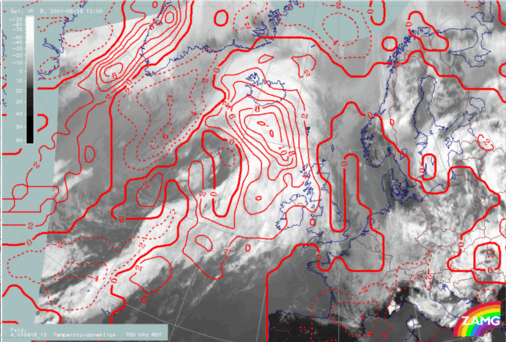Meteorological Physical Background
The Back Bent Occlusion can be formed, if the surface pressure gradient is relatively weak near the center of the low. The low elongates in the direction of the occluded front, and the tail of the front remains almost straight or only slightly curved; it does not curl around the low centre like in other types of Occlusions.
The bending back of an Occlusion due to cold advection
In this case there is a stationary or slowly moving low, towards which an occluded cyclone moves. They merge into each other to some extent and the cold advection from the cold side of the stationary low forces the occluded front of the cyclone to bend back.
On 18 June 2001 at 00.00 UTC there is a Warm Occlusion moving eastwards over the Atlantic. An upper low, that appears just a weak trough on the lower levels, is located west of Iceland:
|
18 June 2001/00.00 UTC - Meteosat IR image; cyan: height contours 500 hPa
|
18 June 2001/00.00 UTC - Meteosat IR image; red: temperature advection 700 hPa
|
On 18 June 2001 at 12.00 UTC the lows have merged into one and there is cold advection originating from the northern side of the Iceland low affecting on the occluded front:
|
18 June 2001/12.00 UTC - Meteosat IR image; cyan: height contours 500 hPa
|
18 June 2001/12.00 UTC - Meteosat IR image; red: temperature advection 700 hPa
|
On the 19 June 2001 at 06.00 UTC there is only one low left, and the cold advection has turned the occluded front into a Cold Front:
|
19 June 2001/06.00 UTC - Meteosat IR image; cyan: height contours 500 hPa
|
19 June 2001/06.00 UTC - Meteosat IR image; red: temperature advection 700 hPa
|
If the cold advection is very strong, the occluded front can bend tightly as it turns into a Cold (or even into an Arctic) Front. In that case the strongest winds are connected with the new Cold Front. The area between the two Cold Fronts is sometimes called "the false warm sector":
The bending back of an occlusion due to a stationary high pressure area
Sometimes Back Bent Occlusions form when they approach a stationary high pressure area. A moving cyclone slows down in front of a high. The occluded front stops and bends back due to the strengthening of the high pressure centre, while the Warm and the Cold Front continue slowly within a weaker high ridge area. In this case the Occlusion can be neutral, but usually these kind of Back Bent Occlusions occur in connection with cold continental highs during the winter. There is cold advection towards the occluded front from the edge of the high pressure, and the back bent front becomes a Cold Front.
Relative streams
From the relative streams it can be seen that the cold air affecting the Occlusion originates from behind a low pressure in the cold airmass.
The development of the Back Bent Occlusion:
- In the first stage there is a Warm Occlusion; the air within the occluded front is rising near the Occlusion point, and remains on a constant level in area of the tail.
- The Occlusion turns into a cold one, and finally it becomes a Cold Front. Behind the Cold Occlusion and the Cold Front the air is sinking.
17 June 2001/18.00 UTC there is a Warm Occlusion southwest of Iceland:
|
17 June 2001/18.00 UTC - Vertical cross section; black: isentropes (ThetaE), red thick: temperature advection - WA, red thin: temperature
advection - CA, orange thin: IR pixel values, orange thick: WV pixel values
|
17 June 2001/18.00 UTC - Meteosat IR image; magenta: relative streams 312K
|
By 18 June 2001/12.00 UTC, the Occlusion has turned into a Cold Occlusion:
|
18 June 2001/12.00 UTC - Vertical cross section; black: isentropes (ThetaE), red thick: temperature advection - WA, red thin: temperature
advection - CA, orange thin: IR pixel values, orange thick: WV pixel values
|
18 June 2001/12.00 UTC - Meteosat IR image; magenta: relative streams 312K
|
|
19 June 2001/00.00 UTC - Vertical cross section; black: isentropes (ThetaE), red thick: temperature advection - WA, red thin: temperature
advection - CA, orange thin: IR pixel values, orange thick: WV pixel values
|
19 June 2001/00.00 UTC - Meteosat IR image; magenta: relative streams 312K
|
It should be noted that when a trough in the polar airmass reaches an occluded cyclone from the rear, the situation can resemble a Back Bent Occlusion in the satellite image or even on the surface chart. In case of a trough, however, the coldest air is within the trough, and the cold advection is ahead of the trough, in contrast with the Back Bent Occlusion, where the cold advection is behind the back bent front.
















